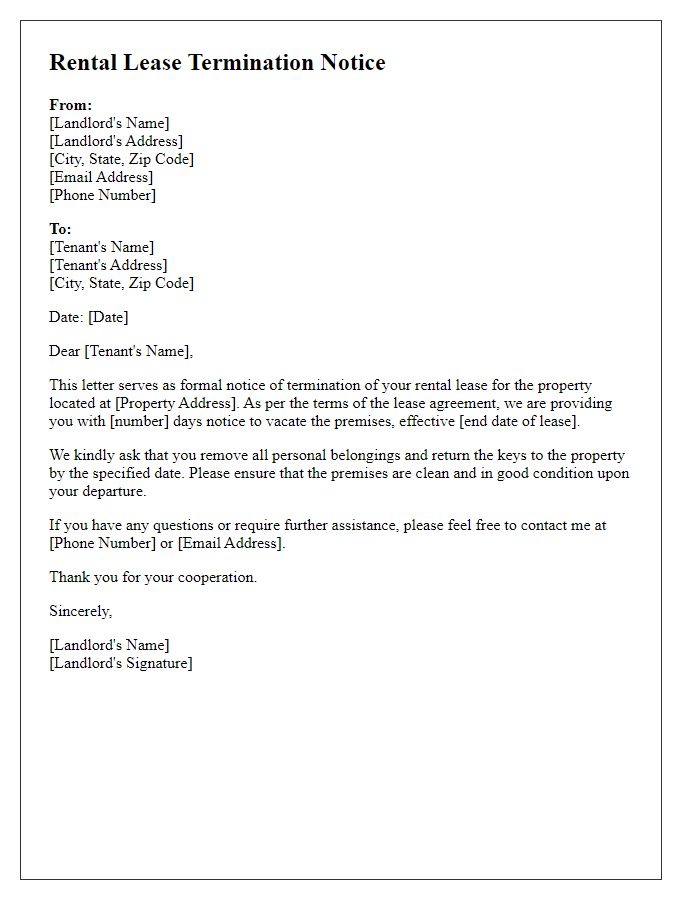If you're considering ending your rental lease, writing a clear and concise termination notice is essential. A well-crafted letter not only communicates your intentions but also ensures you abide by the terms of your lease agreement. In this article, we'll guide you through the crucial elements to include in your notice, whether you're moving for a new job, a change in circumstances, or simply seeking a fresh start. So, grab a cup of coffee and join us as we explore the ins and outs of crafting the perfect lease termination letter!

Tenant and landlord contact information.
In a rental lease termination notice, clear communication of tenant and landlord contact information is essential. The tenant (individual or family's name) should include their complete address, email, and phone number. The landlord (property management company or individual owner) must also provide their name, complete address, phone number, and, if applicable, an email address. This direct access allows for efficient communication regarding the lease termination. Including specific details such as the lease agreement date and the intended termination date clarifies the timeline for both parties. The notice can be delivered via certified mail such as USPS or electronic means to ensure receipt, maintaining legal compliance.
Property address and lease details.
Residential lease termination can occur for various reasons, such as relocation, job changes, or financial difficulties. A rental property, often located at a specific address such as 123 Main Street, Chicago, can have a lease agreement that typically lasts for 12 months, with terms regarding notice periods, security deposits, and rent payments. Notifying landlords or property managers is essential, usually requiring a written notice of 30 days, depending on state laws. Essential details include full names of tenants, dates of occupancy, and final rent payment terms. Clear communication is vital for a smooth transition and avoiding potential disputes.
Termination date and notice period.
A rental lease termination notice should clearly state the termination date, which signifies the last day tenants are authorized to occupy the rental property, and the notice period, typically ranging from 30 to 90 days depending on local regulations and the lease agreement terms. This notice serves as an official communication to inform landlords or property management about the tenant's intention to vacate. It is crucial to adhere to the specific requirements outlined in the rental contract regarding the notice period to avoid potential disputes. Additionally, including important information such as the property address, tenant's name, and the signature of the tenant ensures that the notice is valid and recognized legally.
Reason for termination.
A rental lease termination notice must clearly state the reason for ending the lease agreement. Common reasons can include job relocation (such as moving to a different city for employment), financial difficulties (loss of income or increased expenses), or property issues (such as maintenance problems or safety concerns). It's important to provide specific details, such as the date of termination, which usually requires a notice period (often 30 days). Additionally, including any relevant lease clauses or state laws that support the termination reason can strengthen the notice. Ensuring clarity and professionalism in this communication helps maintain a respectful landlord-tenant relationship.
Tenant's forwarding address for deposit return.
Rental lease termination notice requires clear communication regarding lease ending dates and return of security deposits. Tenant's forwarding address, crucial for deposit return, should be accurate to ensure proper handling. Typical processing time for deposit returns in various states, such as California (21 days required), may influence tenant expectations. Keep in mind potential deductions for repairs beyond normal wear and tear, which are governed by local laws. Including a specific deadline for deposit return can prevent misunderstandings, while documenting all correspondence strengthens tenant rights and minimizes disputes. Properly formatted, this notice maintains professionalism and clarity throughout the termination process.
Letter Template For Rental Lease Termination Notice Samples
Letter template of rental lease termination notice with specific reasons

Letter template of rental lease termination notice with request for security deposit












Comments